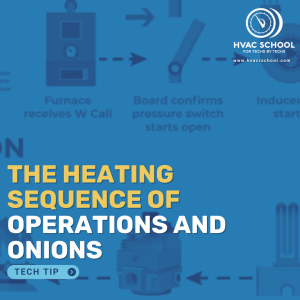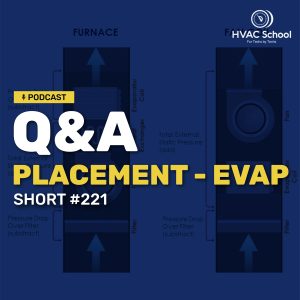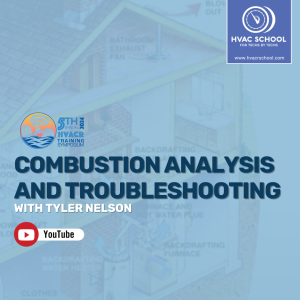BACK
 Silicon Carbide vs. Silicon Nitride Hot Surface Ignitors (HSIs)
Silicon Carbide vs. Silicon Nitride Hot Surface Ignitors (HSIs)
 Different Ignitor Types and How They Work
Different Ignitor Types and How They Work
 Gas Pool Heater Components and Common Issues
Gas Pool Heater Components and Common Issues
 The Chemistry of Combustion In the Wild
The Chemistry of Combustion In the Wild
 Heat Pump Defrost Troubleshooting Tips
Heat Pump Defrost Troubleshooting Tips
 Two Ways to Prevent Freezing in 90%+ Furnace Condensate Lines
Two Ways to Prevent Freezing in 90%+ Furnace Condensate Lines
 The Heating Sequence of Operations and Onions
The Heating Sequence of Operations and Onions
 Soft Lockout vs. Hard Lockout
Soft Lockout vs. Hard Lockout
 Troubleshooting 90%+ Gas Furnaces
Troubleshooting 90%+ Gas Furnaces
 The Tech That Tried to Beat the Compressor – Short #268
The Tech That Tried to Beat the Compressor – Short #268
 From Plumber to HVAC Owner w/ Manly Arnanson
From Plumber to HVAC Owner w/ Manly Arnanson
 Standing Pilot – Short #228
Standing Pilot – Short #228
 History of Gas Furnaces – Redux
History of Gas Furnaces – Redux
 Heat Exchangers and Temperature Rise – Short #227
Heat Exchangers and Temperature Rise – Short #227
 Q&A – Evap Placement – Short #221
Q&A – Evap Placement – Short #221
 Condensing Furnace Drain Guidance w/ AC Service Tech
Condensing Furnace Drain Guidance w/ AC Service Tech
 Q&A – Sizing Heat Pumps for Heat Load – Short #213
Q&A – Sizing Heat Pumps for Heat Load – Short #213
 When to Switch to Emergency Heat? – Short #190
When to Switch to Emergency Heat? – Short #190
 Understanding Dual Fuel
Understanding Dual Fuel
#heating
Tech Tips:

The ignitor of a furnace (or a gas pool heater or other gas-fired appliance) is the heat source, and it can come in one of four varieties: standing pilot, direct spark (DS), intermittent spark (ISI), and hot surface (HSI). We have a tech tip explaining each of these ignitor types in detail, but we’re going […]
Read more

In the furnace sequence of operation, the ignition sequence happens after the safeties have been checked, the inducer fan comes on, and the pressure switch closes. The ignition sequence begins with the ignitor. This part provides the heat needed for combustion (remember: a fire needs heat, oxygen, and fuel), and the ignition process looks a […]
Read more

I know, I know. You came here for HVAC content, so why are we talking about gas pool heaters? Since Kalos is based in Florida, and we don’t have that much of a heating season, we have to look for other forms of work during the winter months. Pool heaters fit the bill quite nicely […]
Read more

If you’ve been following my writing for the last couple of years, you know that I like to blather on and on about combustion analysis. Now, I am by no means an expert on the subject, as I live in North Texas (which is not known for its intense heating season), but I love using […]
Read more

We’ve entered that season of service calls for “smoking heat pumps,” and I figured now is as good a time as any to share a few quick tips for troubleshooting defrost. Of course, the “smoking heat pump” calls can be solved over the phone with a quick explanation of normal defrost conditions—as can the service […]
Read more

This tech tip came from an email sent by Adam Blunkall, a Tennessee-based HVAC technician. He shared some tips to help prevent the issue of freezing in 90%+ furnaces in his market, and we appreciate his insight. Thanks, Adam! If we’re draining our 90%+ furnaces (or any condensing heating system) outside the structure in a […]
Read more

Just like Shrek, I like to think about the heating sequence of operations as an onion—it has layers. And each layer builds upon the previous one. We have written previously in great detail about gas furnaces, from top to bottom. I want to focus today on why there is a sequence of operations and how […]
Read more

If a furnace runs for years and years while tripping the limit switch but satisfies the thermostat, will it ever be noticed? The answer is most likely “no,” but it will depend on whether the furnace utilizes soft or hard lockouts when the limit switch trips. So, what is a soft lockout vs. a hard […]
Read more

This tech tip recaps the livestream by the same name, featuring HVAC School contributors Matt Bruner and Adam Mufich and special guest Ty Branaman. You can watch that livestream on our YouTube channel HERE and visit Ty’s at https://www.youtube.com/@love2hvac. While 80% gas furnaces are relatively commonplace in the Southeastern United States, where HVAC School is […]
Read more
Videos:
Podcasts:

In this short podcast episode, Bryan tells the story of the technology that tried to beat the compressor… and still may someday. We associate cooling with refrigerant… and all the things that come with it, including compressor noise, oil, recovery machines and tanks, leaks, superheat, and regulations. However, there is a means of providing […]
Read more

In this episode, Bryan speaks with Manly, an HVAC professional from Manitoba, Canada, about his journey from working in his family's plumbing business to running his own HVAC company. Manly shares his experiences working in extreme cold weather conditions, where temperatures can drop to -30°C (-22°F), and discusses the unique challenges and emergency response […]
Read more

In this short podcast episode, Bryan talks about the standing pilot gas systems and the ignition strategy in gas-fired appliances. Standing pilots are very simple devices that are common in fuel logs, water heaters, and some pool heaters. These devices have a thermocouple or thermopile; in a thermocouple, two dissimilar metals are connected at […]
Read more

Jim takes us all the way through the history of furnaces, from the Stone Age when he was a child to modern modulating condensing types. The goal of a furnace is to move heat, so a furnace uses heat exchangers to facilitate heat transfer. Furnaces have primary and secondary air. The primary air goes […]
Read more

In this short podcast episode, Bryan talks about heat exchangers and temperature rise in gas furnaces, especially 80% open-combustion gas furnaces. Temperature rise is the difference between the return air temperature and supply air temperature; in cooling, we usually refer to this difference as a delta T or temperature split. The manufacturer sets a […]
Read more

In this short podcast, Bryan talks about evaporator coil placement based on a question submitted by a listener, John. Evap coil placement differs in furnace applications versus air handlers. When we use air conditioners with furnaces, we usually put evaporator coils on the positive side to protect the heat exchanger from rusting out during […]
Read more

Bryan and Craig Migliaccio (AC Service Tech)dive deep into the complexities of managing condensate drainage in high-efficiency (90%+) gas furnaces. The conversation begins with a clear explanation of why these furnaces produce condensate in the first place – they have two heat exchangers that extract so much heat from the combustion gases that water […]
Read more

In this short Q&A podcast, Bryan answers a listener-submitted question about sizing heat pumps for heat load in heating mode, something that we haven't talked much about in the past due to the greater need for cooling in our market. In most cases across the country, a heat pump's heating loads will be greater […]
Read more

In this short podcast episode, Bryan talks about when to switch to emergency heat. He talks about coefficient of performance (COP) and how it's a deciding factor when to run emergency heat, which is when a system ONLY runs the backup heat; it doesn't use it as supplementary heat. When we have a heat […]
Read more
Events:

NOTE: If you cannot view the recording, the video may still be processing. The maximum wait time is 24 hours. We apologize for the delay and appreciate your patience.
Read more




















